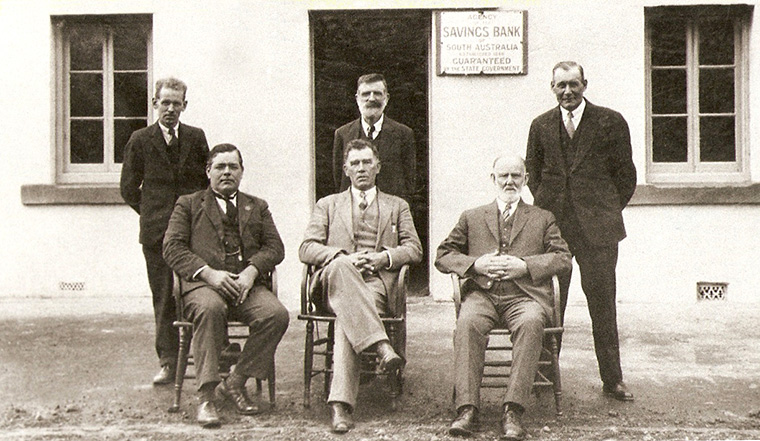Local Councils
Changes to Council Boundaries
With recent alterations to the ward boundaries of the Mt Barker District Council, it is interesting to look back to our previous councils (their amalgamations and changes) including the District Councils of Macclesfield 1853-1935, Meadows 1935-1983 and Mt Barker since 1983.
The District Councils Act was passed in Nov 1852, primarily for the making and improving of roads in South Australia. In 1853 Macclesfield District Council was proclaimed along with the District Councils of Echunga, Kondoparinga, Clarendon and Mt Barker.
The first meeting of the duly elected Macclesfield District Council was held at the Davenport Arms Hotel in Oct 1853. Records refer to ‘our office’ at the Davenport Arms. The venue later alternated between the Macclesfield Hotel and the Davenport Arms. When the Council purchased the Institute in 1891, meetings were held there.
It can be assumed that roads and rates were top of the agenda at early meetings. At one meeting 60 people attended to complain about roads and one resident said ‘the roads were so bad, the only way to pass was by balloon’ (Macclesfield Reflections along the Angas p97).
Any ratepayer could apply to the Council for the formation of a road, or offer to do it themselves (and be paid if the work was to the satisfaction of the overseer). The ultimate decision on the location of roads was made by a vote of council members and there was no compensation for taking a road through one’s property; although fencing costs were met by Council. Community prominence held no influence either and Robert Davenport, on more than one occasion, had his objections over-ruled when the Council voted to put roads through his land.
Although its primary function in the early years was roadmaking, the Council also administered various State Government Boards including, the Licensing Board, a Board for Public Pounds, the School Board, the Destitute Board and under the Board of Health they appointed a doctor to care for the destitute and aborigines. They also made by-laws and appointed constables, who assisted the official police force. It has been said that very little happened in Macclesfield that did not involve the Council.
In 1906 the Macclesfield District Council area was divided into five wards–Township, Battunga, Blackwood, Bugle Ranges and Gray while representatives from each ward made up the Council membership. To gain an idea of the size and population of the district the 1923 SA Civic Record states that ‘Macclesfield Council controlled an area of 35 square miles with a population of 600 and 157 dwellings.’
On Feb 8, 1935 the Mt Barker Courier reported, ‘the SA Local Government Commission appointed under the Local Government Areas (Re-arrangement) Act of 1929, recommended changes to 145 local government boundaries, involving major amalgamations, annexations and re adjustments. The Commission considered that the affairs of local government could be conducted more economically and efficiently with fewer District Councils.’ This was the end of the Macclesfield District Council. The district was consolidated into two wards, Macclesfield and Battunga and these wards became part of the Meadows District Council.
The Macclesfield District Council met for the last time on May 30, 1935 and in its place the outgoing Chairman Gilbert Penna was elected as councillor for the Macclesfield Ward and soon afterwards Mark Haines replaced Ted Fry as the Battunga Ward councillor.

Members of the last Macclesfield Council 1935. Back row: Bert Broadbent, Pat Magin and Dick Mountstephen, Seated Gilbert Penna, Walter Tonkin and Ted Fry.
The Meadows District Council was established on 1 May 1935 by an amalgamation of the earlier Councils of Clarendon, Kondoparinga and portions of Macclesfield and Echunga. The headquarters of the new Council was established at Meadows in the old Council Chambers of the former District Council of Kondoparinga. It became known as the Corporation of the Town of Meadows. and covered a vast area of 578 square kilometers, stretching from the Sturt River at Coromandel Valley and Darlington to the north and Ashbourne in the south.
Over the years as a result of significant urban growth in a predominantly rural area, it developed a dual character. In the urban areas to the north were the metropolitan area suburbs of Coromandel Valley, Happy Valley, Aberfoyle Park, Flagstaff Hill, O’Halloran Hill and parts of Darlington and Reynella. South of these was a vast rural area which included the townships of Clarendon, Kangarilla, Meadows, Macclesfield and Echunga.
In 1977 a branch office was established at Taylors Road, Happy Valley to service more adequately the needs of the residents in the urban area.
In 1983 Macclesfield, Echunga and Kondoparinga were severed from the Meadows District Council and annexed to the adjoining Councils of Strathalbyn and Mount Barker. A statement from Councillor Pat Secker in the Macclesfield Newsletter no. 132, explains the changes as from 1 July 1983 the whole of the Echunga Ward, the towns of Meadows and Prospect Hill and surrounding areas and most of the Macclesfield ward will all be officially part of the Mt Barker Council. Ashbourne, Bull Creek, Paris Creek etc. will become part of the Strathalbyn Council.
The remaining urban area with a population of approximately 24,000 became The Corporation of Meadows and finally on the 3rd November 1983 it was proclaimed to be the Corporation of the City of Happy Valley. (Extract from South Australia-The Civic Record 1836-1986 edited by Penny Matthews and published by Wakefield Press 1986).
Macclesfield History Group, November 2022



